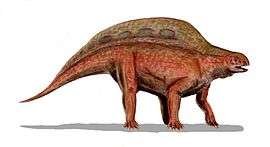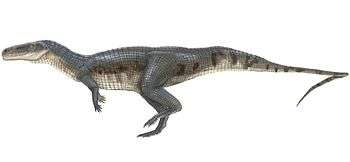Lotosaurus
| Lotosaurus Temporal range: Middle Triassic, Anisian | |
|---|---|
 | |
| Scientific classification | |
| Kingdom: | Animalia |
| Phylum: | Chordata |
| Class: | Reptilia |
| Clade: | Paracrocodylomorpha |
| Branch: | †Poposauroidea |
| Family: | †Lotosauridae Zhang, 1975 |
| Genus: | †Lotosaurus Zhang, 1975 |
| Type species | |
| †Lotosaurus adentus Zhang, 1975 | |
Lotosaurus is an extinct genus of sail-backed poposauroid known from Hunan Province of central China.[1]
Description
Lotosaurus is known from the holotype IVPP V 4881 (or possibly V 4880), articulated well-preserved skeleton, and from the referred specimens IVPP V 48013, skull, articulated and disarticulated skeletal remains of at least ten individuals, all came from a monotypic bonebed. All specimens were collected from the Lotosaurus site, from the Batung Formation (or alternatively Xinlingzhen Formation of the Badong Group[2]), dating to the Anisian stage of the early Middle Triassic, about 245-237 million years ago.[1]
Lotosaurus was 1.5 to 2.5 m (4.9 to 8.2 ft) long and a heavily built quadruped. It was a herbivore, shearing off leaves with its toothless, beaked jaws. Lotosaurus, like some other members of the Poposauroidea, had a sail on its back, granting it an appearance superficially similar to that of Permian pelycosaurs like Dimetrodon and Edaphosaurus, although not as high.[3]
Lotosaurus was originally thought to be a thecodont, probably related to Ctenosauriscus and other archosaur taxa with elongated neural spines (=Ctenosauriscidae).[4] Many recent cladistic analyses confirmed this affinity. Nesbitt (2007) was the first to suggest that Lotosaurus is more closely related to Shuvosaurus (a shuvosaurid) than to Arizonasaurus (a ctenosauriscid).[5] In his massive revision of archosaurs which included a large cladistic analysis, Sterling J. Nesbitt (2011) found Lotosaurus to be a poposauroid, sister group of the Shuvosauridae, and therefore it is not included in the Ctenosauriscidae.[1] Further studies confirmed these results.[2]
Etymology
Lotosaurus was first named by Fa-kui Zhang in 1975 and the type species is Lotosaurus adentus. Lotosaurus was originally placed in its own family, Lotosauridae, which named by Zhang in 1975. The specific name is derived from the Greek a and denta, meaning "toothless", in reference to its toothless beak.[4]
References
- 1 2 3 Sterling J. Nesbitt (2011). "The Early Evolution of Archosaurs: Relationships and the Origin of Major Clades" (PDF). Bulletin of the American Museum of Natural History. 352: 1–292. doi:10.1206/352.1.
- 1 2 Richard J. Butler, Stephen L. Brusatte, Mike Reich, Sterling J. Nesbitt, Rainer R. Schoch and Jahn J. Hornung (2011). "The sail-backed reptile Ctenosauriscus from the latest Early Triassic of Germany and the timing and biogeography of the early archosaur radiation". PLoS ONE. 6 (10): e25693. doi:10.1371/journal.pone.0025693. PMC 3194824
 . PMID 22022431.
. PMID 22022431. - ↑ Benson, R.B.J. & Brussatte, S. (2012). Prehistoric Life. Dorling Kindersley. p. 216. ISBN 978-0-7566-9910-9.
- 1 2 Fa-kui Zhang (1975). "A new thecodont Lotosaurus, from Middle Triassic of Hunan". Vertebrata PalAsiatica. 13 (3): 144–147.
- ↑ Sterling J. Nesbitt (2007). "The anatomy of Effigia okeeffeae (Archosauria, Suchia), theropod-like convergence, and the distribution of related taxa" (PDF). Bulletin of the American Museum of Natural History. 302: 84 pp. doi:10.1206/0003-0090(2007)302[1:TAOEOA]2.0.CO;2.



